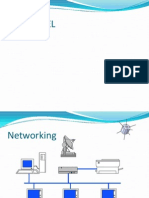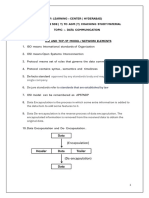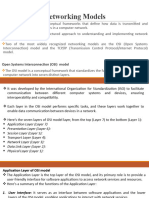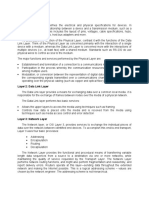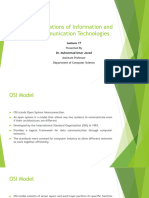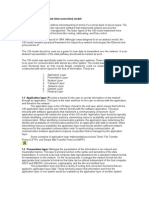0 ratings0% found this document useful (0 votes)
5 viewsIntroduction to OSI Model
Uploaded by
andrewsherwin2007Copyright
© © All Rights Reserved
Available Formats
Download as DOCX, PDF, TXT or read online on Scribd
0 ratings0% found this document useful (0 votes)
5 viewsIntroduction to OSI Model
Uploaded by
andrewsherwin2007Copyright
© © All Rights Reserved
Available Formats
Download as DOCX, PDF, TXT or read online on Scribd
You are on page 1/ 5
1.
Introduction to OSI Model:
o Describes the complexity and journey of data through the network using the
OSI model, which standardizes the communication process between different
computer systems.
2. Physical Layer:
o The lowest layer deals with the physical connection and data transmission in
the form of bits over hardware like Ethernet cables.
3. Data Link Layer:
o Manages error-free data transfer between adjacent nodes and transforms bits
into frames for data transmission.
o Uses MAC (Media Access Control) addresses for identifying devices on the
network.
4. Network Layer:
o Responsible for routing packets across the network and managing IP
addressing.
o Determines the best path for data to reach its destination.
5. Transport Layer:
o Ensures reliable data transmission between hosts, providing error-checking
and data segmentation.
o Common protocols include TCP (Transmission Control Protocol) and UDP
(User Datagram Protocol).
6. Session Layer:
o Manages sessions or connections between two computers, ensuring they stay
connected and data flows smoothly.
7. Presentation Layer:
o Translates data into a readable format for the application layer, handling data
encryption and decryption.
o Ensures that data is presented in a way that the receiving application can
understand.
8. Application Layer:
o The highest layer, closest to the end-user, providing network services directly
to applications.
o Handles application-specific functionalities like email, file transfer, and web
browsing.
9. Data Journey:
o Describes how data moves from one computer through these layers to another,
highlighting the tasks and responsibilities of each layer to ensure that data is
transmitted accurately and securely.
The OSI model serves as a guide for understanding how different networking protocols
interact with each other and how data is processed and transmitted across a network.
OSI Model (Explanations in Details)
1. Physical Layer
Function: The Physical Layer is the first and lowest layer of the OSI model. It is
responsible for the physical connection between devices. This layer deals with the
hardware aspects of data transmission, including cables, switches, network interface
cards, and other physical mediums. The Physical Layer defines the means of
transmitting raw bits over a physical data link connecting network nodes.
Data Transmission: Data is transmitted in the form of bits (0s and 1s). The layer
converts digital bits into electrical, radio, or optical signals, depending on the
transmission medium.
Responsibilities: It includes determining the voltage levels, timing of voltage
changes, physical data rates, maximum transmission distances, and connectors. It also
handles data encoding, modulation, and error detection and correction at the hardware
level.
2. Data Link Layer
Function: The Data Link Layer is responsible for establishing a reliable link between
two directly connected nodes. It manages the error detection and correction from the
Physical Layer and organizes data into frames.
Frames: Data Link Layer divides data into frames, each containing a data packet to
be transmitted. It ensures that frames are error-free and sent sequentially.
MAC and LLC: The layer is divided into two sublayers:
o Media Access Control (MAC): Controls how devices on the same network
segment access the physical medium. It is responsible for the addressing and
channel access control mechanisms that make it possible for several terminals
or network nodes to communicate within a multi-point network.
o Logical Link Control (LLC): Manages frame synchronization, flow control,
and error checking. It also provides a mechanism for multiplexing and
demultiplexing multiple network protocols.
Error Handling: The Data Link Layer uses mechanisms like Cyclic Redundancy
Check (CRC) for detecting errors in the transmitted frames and may request
retransmission of corrupted frames.
3. Network Layer
Function: The Network Layer is responsible for routing, forwarding, and logical
addressing. It determines how data is transferred between different networks and the
best path for the data to take.
IP Addressing: This layer uses logical addresses, such as IP addresses, to identify
devices on the network. It ensures that data reaches its correct destination, even across
multiple networks.
Routing: The Network Layer makes decisions about the routing of packets,
determining the optimal path for data transmission based on various metrics such as
distance, cost, or network congestion.
Packet Encapsulation: The layer encapsulates data into packets, adding headers
containing routing information. These headers include source and destination IP
addresses.
Fragmentation: If a packet is too large to be transmitted over the network, the
Network Layer may fragment it into smaller packets, which are reassembled at the
destination.
4. Transport Layer
Function: The Transport Layer is responsible for end-to-end communication between
devices. It ensures that data is transferred from the source to the destination accurately
and reliably.
Segmentation and Reassembly: The Transport Layer divides large data streams into
smaller segments for transmission. It also reassembles these segments at the
destination to reconstruct the original data.
Error Checking: This layer uses error-detection and error-recovery mechanisms,
ensuring that data is delivered without errors. If errors are detected, the Transport
Layer may request retransmission of the data.
Flow Control: The Transport Layer manages the flow of data to prevent congestion,
ensuring that the sender does not overwhelm the receiver with too much data at once.
Protocols: Common Transport Layer protocols include TCP (Transmission Control
Protocol), which provides reliable, connection-oriented communication, and UDP
(User Datagram Protocol), which offers faster, connectionless communication without
guaranteed delivery.
5. Session Layer
Function: The Session Layer is responsible for establishing, managing, and
terminating connections (sessions) between applications. It ensures that sessions
remain open and can handle communication over an extended period.
Session Management: This layer manages the dialogue control between devices,
ensuring that communication sessions are properly established, maintained, and
terminated.
Synchronization: The Session Layer can insert checkpoints or synchronization points
into the data stream, allowing sessions to be resumed from a specific point in case of
an interruption.
Dialog Control: It manages the flow of data in either a half-duplex or full-duplex
mode, determining which device can send data at a given time.
Examples: Protocols at the Session Layer include NetBIOS and PPTP (Point-to-Point
Tunneling Protocol).
6. Presentation Layer
Function: The Presentation Layer is responsible for translating data between the
format used by the application layer and the underlying network format. It ensures
that data sent by the application layer of one system is readable by the application
layer of another system.
Data Translation: The layer translates data from one format to another, such as
converting character encoding (e.g., ASCII to EBCDIC) or translating data structures.
Encryption and Decryption: The Presentation Layer handles data encryption and
decryption, ensuring data security during transmission.
Compression: It may also compress data to reduce the size of the data for faster
transmission and decompress it at the receiving end.
Examples: Common formats and protocols used at this layer include JPEG, GIF,
MPEG, and SSL/TLS.
7. Application Layer
Function: The Application Layer is the topmost layer of the OSI model and is closest
to the end-user. It provides network services directly to user applications, such as web
browsers, email clients, and file transfer programs.
User Interface: This layer interacts directly with software applications to provide
communication functions as required by the end-user. It serves as a window for users
and application processes to access network services.
Network Services: It provides services such as file transfer, email, remote login, and
network management.
Protocol Examples: Common protocols used at this layer include HTTP (Hypertext
Transfer Protocol), FTP (File Transfer Protocol), SMTP (Simple Mail Transfer
Protocol), and DNS (Domain Name System).
Data Interaction: The Application Layer ensures that the data is presented to the user
in a readable format and provides mechanisms for interacting with the network
resources.
Data Journey Through the OSI Layers:
From Sender to Receiver: When data is transmitted from one device to another, it
starts at the Application Layer, where it is formatted for transmission. The data then
passes down through each subsequent layer (Presentation, Session, Transport,
Network, Data Link, Physical), with each layer adding its own specific header or
footer information. At the receiving end, the data travels back up through the layers in
reverse order, with each layer removing the header/footer added by its corresponding
layer at the sender's side, ultimately delivering the original data to the receiving
application.
Error Handling and Reliability: Throughout this process, several layers are
responsible for ensuring data integrity, error correction, and reliable delivery. For
example, the Transport Layer ensures that data segments are reassembled correctly
and that lost segments are retransmitted, while the Data Link Layer handles error
detection and frame synchronization.
Routing and Addressing: The Network Layer plays a critical role in determining the
path data takes through the network, using routing algorithms to choose the best route
based on various factors such as network topology, congestion, and link costs. Logical
addressing ensures that data reaches the correct destination.
This layered approach to network communication allows for a modular and scalable system
where each layer can evolve independently, ensuring compatibility and interoperability across
different types of networks and devices.
You might also like
- P1: Discuss The Benefits and Constraints of Different Network Types and Standards50% (2)P1: Discuss The Benefits and Constraints of Different Network Types and Standards8 pages
- Computer Networks: by Damera Venkatesh Assistant ProfessorNo ratings yetComputer Networks: by Damera Venkatesh Assistant Professor22 pages
- Network Models: Dept. of Computer Engineering Faculty of EngineeringNo ratings yetNetwork Models: Dept. of Computer Engineering Faculty of Engineering22 pages
- OSI Model 7 Layers Explained in Computer NetworkNo ratings yetOSI Model 7 Layers Explained in Computer Network8 pages
- Network Models: Dept. of Computer Engineering Faculty of EngineeringNo ratings yetNetwork Models: Dept. of Computer Engineering Faculty of Engineering22 pages
- What Are Network Protocols - IT Glossary - SolarWindsNo ratings yetWhat Are Network Protocols - IT Glossary - SolarWinds3 pages
- 1.0 The OSI (Open Systems Interconnection) Model100% (1)1.0 The OSI (Open Systems Interconnection) Model5 pages
- Computer Networking Notes for Tech Placements (1)No ratings yetComputer Networking Notes for Tech Placements (1)16 pages
- Topologi UKK Paket 2 - 2025 - revisi 26-1-2025No ratings yetTopologi UKK Paket 2 - 2025 - revisi 26-1-20251 page
- CCNP Enterprise Design ENSLD 300 420 Official Cert Guide 2nd Edition Anthony Bruno & Steve Jordan - The latest ebook is available for instant download now100% (5)CCNP Enterprise Design ENSLD 300 420 Official Cert Guide 2nd Edition Anthony Bruno & Steve Jordan - The latest ebook is available for instant download now75 pages
- Claroty Protocol Support List CTDV4.7 EdgeV1.4 (1)No ratings yetClaroty Protocol Support List CTDV4.7 EdgeV1.4 (1)6 pages
- 101 Labs Cisco CCNA Hands On Practical Labs for the 200 301 Implementing and Administering Cisco Solutions Exam 4th Edition by Paul Browning, Farai Tafa 0992823951 978-0992823955 - Read the ebook now or download it for a full experience100% (5)101 Labs Cisco CCNA Hands On Practical Labs for the 200 301 Implementing and Administering Cisco Solutions Exam 4th Edition by Paul Browning, Farai Tafa 0992823951 978-0992823955 - Read the ebook now or download it for a full experience76 pages
- (Ebook) Connection-oriented Networks: SONET/SDH, ATM, MPLS and Optical Networks by Harry G. Perros ISBN 9780470021637, 9780470021644, 0470021632, 0470021640 pdf download100% (1)(Ebook) Connection-oriented Networks: SONET/SDH, ATM, MPLS and Optical Networks by Harry G. Perros ISBN 9780470021637, 9780470021644, 0470021632, 0470021640 pdf download47 pages
- tejas-brochure-tj1400p-m1-10gigabit-switchesNo ratings yettejas-brochure-tj1400p-m1-10gigabit-switches12 pages
- 3.5.5 Packet Tracer - Investigate the TCP-IP and OSI Models in Action-1No ratings yet3.5.5 Packet Tracer - Investigate the TCP-IP and OSI Models in Action-14 pages
- Textnow - Wed, 05 Feb 2025 14-28-01 GMT.logNo ratings yetTextnow - Wed, 05 Feb 2025 14-28-01 GMT.log23 pages
- Computer Networking A Top-Down Approach 7th Edition Kurose Solutions Manual - Download Now And Start Reading The Complete Content100% (5)Computer Networking A Top-Down Approach 7th Edition Kurose Solutions Manual - Download Now And Start Reading The Complete Content45 pages
- P1: Discuss The Benefits and Constraints of Different Network Types and StandardsP1: Discuss The Benefits and Constraints of Different Network Types and Standards
- CISA Exam-Testing Concept-OSI Architecture (Domain-5)From EverandCISA Exam-Testing Concept-OSI Architecture (Domain-5)
- Computer Networks: by Damera Venkatesh Assistant ProfessorComputer Networks: by Damera Venkatesh Assistant Professor
- Network Models: Dept. of Computer Engineering Faculty of EngineeringNetwork Models: Dept. of Computer Engineering Faculty of Engineering
- Network Models: Dept. of Computer Engineering Faculty of EngineeringNetwork Models: Dept. of Computer Engineering Faculty of Engineering
- What Are Network Protocols - IT Glossary - SolarWindsWhat Are Network Protocols - IT Glossary - SolarWinds
- CCNP Enterprise Design ENSLD 300 420 Official Cert Guide 2nd Edition Anthony Bruno & Steve Jordan - The latest ebook is available for instant download nowCCNP Enterprise Design ENSLD 300 420 Official Cert Guide 2nd Edition Anthony Bruno & Steve Jordan - The latest ebook is available for instant download now
- Claroty Protocol Support List CTDV4.7 EdgeV1.4 (1)Claroty Protocol Support List CTDV4.7 EdgeV1.4 (1)
- 101 Labs Cisco CCNA Hands On Practical Labs for the 200 301 Implementing and Administering Cisco Solutions Exam 4th Edition by Paul Browning, Farai Tafa 0992823951 978-0992823955 - Read the ebook now or download it for a full experience101 Labs Cisco CCNA Hands On Practical Labs for the 200 301 Implementing and Administering Cisco Solutions Exam 4th Edition by Paul Browning, Farai Tafa 0992823951 978-0992823955 - Read the ebook now or download it for a full experience
- (Ebook) Connection-oriented Networks: SONET/SDH, ATM, MPLS and Optical Networks by Harry G. Perros ISBN 9780470021637, 9780470021644, 0470021632, 0470021640 pdf download(Ebook) Connection-oriented Networks: SONET/SDH, ATM, MPLS and Optical Networks by Harry G. Perros ISBN 9780470021637, 9780470021644, 0470021632, 0470021640 pdf download
- 3.5.5 Packet Tracer - Investigate the TCP-IP and OSI Models in Action-13.5.5 Packet Tracer - Investigate the TCP-IP and OSI Models in Action-1
- Computer Networking A Top-Down Approach 7th Edition Kurose Solutions Manual - Download Now And Start Reading The Complete ContentComputer Networking A Top-Down Approach 7th Edition Kurose Solutions Manual - Download Now And Start Reading The Complete Content

